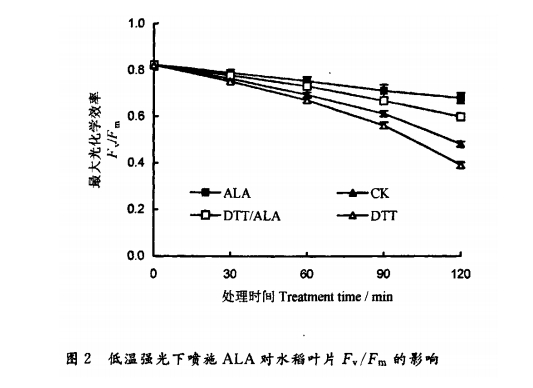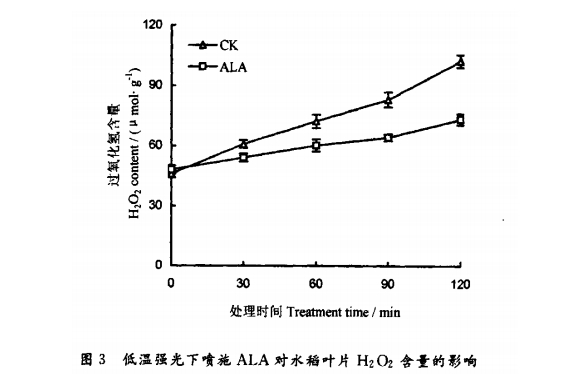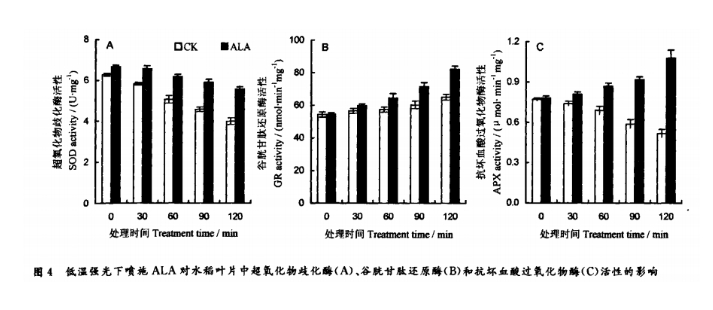
During the growth period of rice, early spring seedlings often encounter low temperature and strong light stress that suddenly turns sunny after continuous rain, causing seedling rot. The main reason is that under low temperature and strong light, light energy utilization is limited, and excess light energy harms the photosynthetic organs of rice, that is, causes the generation of low temperature light inhibition. When the light energy absorbed by the plant exceeds the need for photosynthesis, light stress will be formed, resulting in the production of reactive oxygen species such as superoxide anion and H2O2, which can generate more active and toxic ·OH. Reactive oxygen species have a potentially toxic effect on cells, so it must be effectively controlled to achieve a dynamic balance between their production and removal. In the long-term evolution process, rice has formed two main protective mechanisms: on the one hand, excess energy can be dissipated through the lutein cycle, for example, long-term ABA treatment can enhance the defense ability against light inhibition by strengthening the lutein cycle; On the other hand, the ability of plants to adapt to low temperature and strong light can also be enhanced by improving the scavenging capacity of reactive oxygen species. Some experts have demonstrated that increasing the activity of antioxidant enzymes can improve the defense ability of plants against low temperature photoinhibition.
5-aminolevulinic acid (5-ALA) is a key precursor of all biological porphyrins such as chlorophyll and ferrous heme. In plants, high concentration of ALA can be used as herbicide, while low concentration of ALA can regulate plant growth and development, promote crop yield, improve plant salt tolerance and cold adaptability. Therefore, the application of ALA in facility agriculture has become a research hotspot. However, it has not been reported in detail whether low concentration of ALA can enhance plant tolerance to low temperature and strong light. The purpose of this study was to study the effect of ALA on the protection mechanism of rice seedlings under low temperature and strong light, and to provide theoretical basis for further rational application of ALA in rice and other crops to protect against the damage of low temperature and strong light.
The rice seeds were soaked in 0.1% high mercury chloride solution for 15min, then washed with tap water, and planted in a petri dish covered with wet filter paper at a culture temperature of (25±2)℃ and light intensity of 500μmol/(m2·s) for 12 h per day. After 1 leaf and 1 heart stage, the seedlings were selected and moved to a pot with uniform nutrition, with 6 seedlings per pot, and placed under natural light conditions in the net room. At 4 leaves and 1 core, 50, 150, 250 mg/L ALA was evenly sprayed at 20:00 every day (adding 0.01% Twain), 2 mL was sprayed in each basin, water was sprayed as the control (adding 0.01% Twain), and the fifth fully extended leaf was used for the experiment.
Low temperature photosuppression treatment
The middle part of the 4 cm long blade was cut and placed in a tank connected with a super circulating water bath. The water temperature was controlled at 6℃, the upper surface of the blade was facing upward, and the light source was a mercury lamp. By controlling the distance between the blade and the mercury lamp, the blade was exposed to a light intensity of 1200μmol/(m2·s), and the leaves were treated for 30, 60, 90, and 120 min, respectively.
Dithiothreitol (DTT) treatment
The fifth leaf sheath was cut in water, and then inserted in 3 mol/L dithiothreitol (DTT) solution, with distilled water treatment as the control. After treatment at 15μmol/(m2·s) light intensity and 25℃ for 3 h, DTT and distilled water were introduced into the leaves by transpiration.
Determination of photosynthetic oxygen release rate
The rate of photosynthetic oxygen release was determined by oxygen electrode method (Chlorolab 2, Hansatech, UK). The reaction medium (NaHCO3 20 mmol/L, Tris 60 mmol/L) was infiltrated into the leaves by vacuum infiltration method. The light intensity was measured at 1000μmol/(m2·s) and the temperature was 25℃.
Determination of chlorophyll fluorescence parameters
The chlorophyll fluorescence parameters were determined by pulse-modulated fluorometer (PAM-2100, WaIz, Germany) after 30 min pre-dark adaptation. The modulated light, acting light and saturated pulse light were 0.07, 210 and 6 000μmol/(m2·s), respectively. Fv/Fm=(fm-fo)/Fm.
Determination of antioxidant enzyme activity and H2O2 content
The activities of superoxide dismutase (SoD), glutathione reductase (GR), ascorbate peroxidase (APX) and H2O2 content were determined according to Jiang et al.
Determination of ferrous heme:
The leaves were ground with acetone and liquid ammonia (volume ratio 9:1), centrifuged to remove supernatant, precipitated with 80% acetone for 3 times, and finally precipitated with 2%HCl acetone for 3 times, and then the extracted mixture was washed with non-peroxide ether for 3 times, after concentration and determination, the extinction value per 1nmol was 20.7.
The above treatment was repeated 3 times.
Effects of different concentrations of ALA sprayed at low temperature and strong light on photosynthetic rate of rice leaves
Under 6℃ and 1200μmol/(m2·s) light, the photosynthetic rate of plant leaves decreased significantly with the extension of low temperature and strong light treatment time. After 2 h, the photosynthetic rate of control leaves decreased by 83%. The photosynthetic rate of leaves sprayed with 50, 150 and 250 mg/L ALA decreased by 77%, 59% and 42%, respectively (Figure 1). It can be seen that ALA can obviously alleviate the effect of low temperature and strong light on the photosynthetic rate, and its mitigation effect is strengthened with the increase of concentration.

Chlorophyll fluorescence of rice leaves was induced by spraying ALA at low temperature and strong light
The maximum photochemical efficiency Fv/Fm reflects the quantum efficiency when all PSⅡ reaction centers are open, and is usually used as an indicator to measure the degree of photosuppression of PSⅡ. Under 6℃ and 1200μmol/(m2·s) light condition, Fv/Fm showed a decreasing trend with the extension of treatment time, which indicated that serious photoinhibition occurred in rice. After 2 h, the Fv/Fm of the control leaves decreased by 41.06%, while the Fv/Fm of the leaves sprayed with 250 mg/L ALA only decreased by 17.02%, the difference between the two was extremely significant (P<0.01)(FIG. 2), indicating that the ALA sprayed had a significant protective effect on the photosynthetic organs of rice. DTT is a specific inhibitor of the lutein cycle. In order to further understand the role of lutein cycling in the low temperature photoinhibition and protection mechanism of rice and the effect of spraying 250 mg/LALA on the protective mechanism of rice lutein cycling, this study also compared the DTT treatment and the resistance of ALA sprayed leaves to low temperature and strong light. The results showed that the Fv/Fm of both blades decreased significantly after DTT treatment with the extension of treatment time. After 2 h of treatment under low temperature and strong light, Fv/Fm of rice leaves treated with DTT decreased by 18% compared with the control, while Fv/Fm of rice leaves treated with DTT/ALA decreased by 12% compared with ALA treatment (FIG. 2), with no significant difference between the two (P>0.1). In conclusion, although the heat dissipation dependent on the lutein cycle plays an important role in the defense mechanism of low temperature photoinhibition in rice, it is not the main reason why ALA improves the resistance of rice to low temperature photoinhibition.

Effect of ALA spray on H2O2 content in rice leaves under low temperature and strong light
Photoinhibition of PSⅡ is often closely related to H2O2 produced by photosynthetic organs. The content of H2O2 in the leaves was further analyzed under low temperature and strong light. The results showed that when the leaves were exposed to 6℃ and 1200μmol/(m2·s) light, with the extension of treatment time, the content of H2O2 in the leaves sprayed with 250 mg/L ALA and the control was significantly increased, but the increase amplitude was obviously different between the two. After 2 h of treatment, H2O2 content in control leaves increased by 156%, while that in sprayed ALA leaves increased by 50%, and the difference between the two was extremely significant (P<0.01). It can be seen that ALA significantly reduces the H2O2 content in leaves (Figure 3).

Effect of ALA spray on antioxidant oxidase activity in rice leaves under low temperature and strong light
Over the long course of evolution, plants have developed a complex defense system for removing reactive oxygen species. As shown in Figure 4, after low temperature and strong light treatment, with the extension of treatment time, the antioxidant oxidase activity in the leaves sprayed with 250 mg/LALA was significantly higher than that in the control leaves. After 2 h, SOD activity decreased by 33% in the control group, but only decreased by 16% in the leaves sprayed with ALA (FIG. 4-a). GR activity increased by 20% in the control group and 31% in the leaves sprayed with ALA (FIG. 4-b). In particular, APX activity decreased by 33% in control samples, but increased by 138% in leaves sprayed with ALA (FIG. 4-C). All the above differences reached a very significant level (P<0.01). The results showed that ALA significantly promoted the activity of antioxidant enzymes in rice leaves.

Discussion and analysis
Low concentration of ALA can significantly alleviate the effects of low temperature and strong light on photosynthesis in rice, which has also been verified in other rice varieties (data is not listed), but the mitigation effects are inconsistent with different concentrations. Under the experimental conditions, 250 mg/L ALA had the greatest mitigation effect on rice photosynthesis under low temperature and strong light. Studies have shown that different exogenous substances have different protective mechanisms against low temperature light suppression. Some experts believe that the increased ability of rice to adapt to low temperature photoinhibition by spraying ascorbic acid is due to the enhancement of lutein circulation. However, the results of this study show that the mechanism of ALA alleviating photoinhibition in rice is obviously different from that of ascorbic acid, and it does not protect the photosynthetic apparatus by enhancing the circulation of lutein to dissipate excess light energy. The degree of photoinhibition in plants is often closely related to H2O2 produced by photosynthetic organs. In chloroplasts, the main scavenging enzymes of active oxygen species are SOD, GR and APX. Among them, SOD is one of the main enzymes to remove O2, which converts O2 into H2O2, while APX has a strong ability to reduce H2O2, GR is also a key enzyme to remove reactive oxygen species in chloroplasts, and it clears H2O2 and O2 in cells through the ASA-GSH-NADPH cycle, thus avoiding the potential damage of reactive oxygen species. Therefore, SOD, GR and APX can reduce the damage of photoinhibition on photosynthetic mechanism. The GR activity of rice leaves treated with ALA was significantly increased compared with control under stress. It was also observed that ALA treated rice leaves maintained higher SOD activity, but the specific mechanism was not clear. In this study, it was suggested that the decrease of H2O2 content in rice leaves after spraying ALA under photoinhibition conditions was mainly due to the significant increase in GR and APX activities. In particular, the APX activity decreased by 33% in the control group, while the activity of ALA sprayed leaves increased by 138%. This suggests that ALA can improve the scavenging ability of ROS under photoinhibition by inducing the increase of APX activity in leaves. Some experts also believe that isolated chloroplasts increase the production of newly synthesized heme due to the external supply of ALA, and that after treating peas with carbon-14 labeled ALA, these carbon-14 appear in the cogroups of peroxidase molecules and some other porphyrin molecules, such as cytochrome and peroxidase. Therefore, we further determined the content of heme in leaves. The content of heme in control rice leaves was (0.69 soil 0.065)μg/g, while the content of heme in leaves sprayed with ALA was (0.99±0.105)μg/g, which significantly increased the content of heme in leaves. Therefore, we believe that under stress conditions, the increase of APX may be caused by the accumulation of heme pool in the body. In conclusion, this study suggested that rice leaves sprayed with ALA could significantly alleviate the low temperature photoinhibition of PSⅡ. Its main protection pathway is not by enhancing the heat dissipation dependent on the lutein cycle, but by significantly increasing the activities of GR and APX in the chloroplast antioxidant oxidase system, stabilizing the activity of SOD, clearing the accumulated H2O2, and thus alleviating the photoinhibition of PSⅡ. The increased activity of APX was mainly caused by the accumulation of heme pool.
In this paper, the main mechanism of rice adaptation to low temperature photoinhibition was studied by spraying 250mg/L 5-aminolevulinic acid (5-ALA). The main mechanism by which ALA at low concentration improves rice resistance to low temperature and bright light is not to enhance heat dissipation through lutein cycling, but to significantly increase the activities of ascorbate peroxidase (APX) and glutathione reductase (GR) in chloroplast antioxidant enzyme system. Reduce the decline in superoxide dismutase (SOD) activity, thereby reducing the content of hydrogen peroxide (H2O2). Reduce photoinhibition of PSⅡ. Moreover, the increased activity of APX may be caused by the accumulation of heme pool.